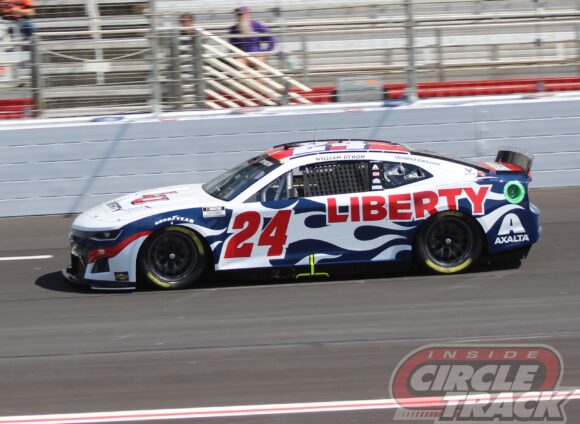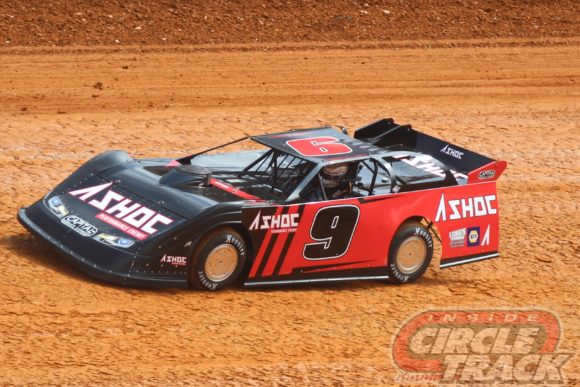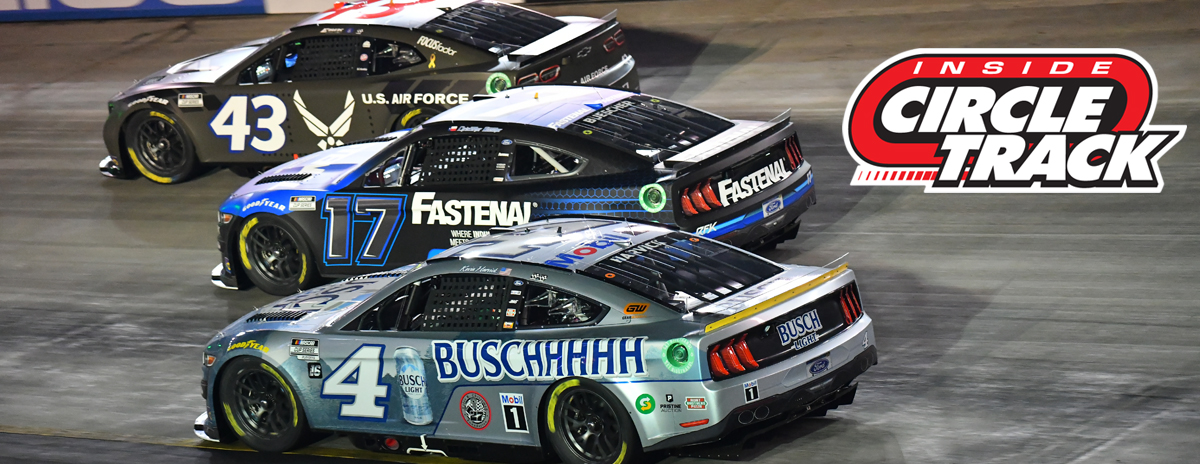
*Turn 2 Blog is a regular feature on InsideCircleTrack.com. Here, site operators Michael Moats and Richard Allen take turns offering their thoughts on the NASCAR and pavement short track racing topics of the day.
So far in the 2022 season there have been two NASCAR Cup Series short track races(Richmond & Martinsville) and both have been remarkably uneventful. While the Next Gen car seems to have improved the racing on the intermediate tracks, has it done so at the expense of the short tracks?
Richard: The first two short track races of 2022 have been rather uneventful.
There were a total of five cautions at the Richmond Raceway but two of those were for stage breaks. Ultimately, the Toyota Owners 400 ended with a 137-lap green flag run but it was made interesting in the sense that differing tire strategies allowed Denny Hamlin to track down William Byron and take the lead with just four laps remaining.
The Blue Emu Maximum Pain Relief 400 at Martinsville Speedway only saw a total of four yellow flags with two of those being for stage breaks. A bit of spice was added when the final of those cautions came at just the right moment to allow for a green/white/checkered finish. However, nothing really happened over those closing laps and William Byron finished out the night by leading the final 82 circuits after having only surrendering the lead briefly during a round of green flag pit stops.
And who would have guessed there would be green flag pit stops at Martinsville?
I watched the Richmond race on television and the Martinsville race from the grandstands. While sitting there freezing as the result of a bitterly cold wind, I thought about why these two short track races have not been as action packed as we have grown accustomed to from this type of venue.
At first, I wondered of the weather played a role in Martinsville as it rained(and even snowed) causing the start to be delayed by about an hour. In my mind I reasoned that the drivers were simply taking it a bit easy just to make sure they got the first two stages in so that the race would be official should precipitation return. But once that point was reached, there wasn’t much else to take place once Byron took the lead after a quick pit stop at the stage 2 break then went largely unchallenged after that.
The cold did seem to have an impact regarding the grip level in the tires as the drivers had some difficulty keeping control immediately following pit stops.
Even though the sample size is small, I wondered how much of a role the new car has played in this sudden change of racing style on short tracks. After all, the NASCAR Xfinity Series does not use the Next Gen and there was no shortage of action in their last two races(and even after the race in Martinsville). This car is very different from its predecessor so at least some of the difference has to be attributed to the car and the adjustment period that goes with it.
For example, and this is just one thought, the brakes are far better on the Next Gen than was the case on the Gen 6. Brakes have always been a major factor at Martinsville but if that component is now so much better that drivers can run the car as hard as they need to into the corners, it can keep some separation from the car behind and thus eliminate the ‘Bump and Run’.
Also, there has been talk of the tires being so good that they don’t wear out but I’m not so sure about that because we did see tire wear play into the Richmond race. Again, perhaps the cold played a role.
In the end, these past two races, especially Martinsville, did not produce what many had hoped for. There doesn’t have to be wrecking for there to be entertaining racing but there does need to be passing with a side order of bumping and running. We haven’t seen much of that in the Cup Series and the car has to be at least somewhat of a factor.
Michael: There was an interesting conversation on the Fox broadcast in which Clint Bowyer and Chad Knaus mentioned the elimination of the ride height rule and how it might have made short track racing worse instead of better. Bowyer said that was the point where things changed, to which Knaus agreed. It was a short, but interesting conversation.
If Bowyer and Knaus have figured this out, why can’t NASCAR address this? I’m not saying this was the only reason why the Martinsville race stunk. It seems like NASCAR is always tinkering in areas where it shouldn’t be tinkering.
My guess is there were several factors that made the Martinsville race so bad. One, with the cold temperatures for the race, the track did not take much rubber at all. That led to basically everyone running the same line. A number of drivers mentioned that during the race and in post-race interviews. Two, the jury is still out whether the Next Gen car is a good car for short track racing. On paper, it should be a good car everywhere. So far, they’ve produced two duds. The Martinsville race was one of the worst races I have seen since the infamous Jeff Burton/restrictor plate race at New Hampshire.

William Byron won an eventless race in Martinsville
With the Food City Dirt Race at the Bristol Motor Speedway next up for the NASCAR Cup Series, there will obviously be a good deal of conversation regarding the new found alliance between NASCAR and dirt racing. This question is actually a two-fold one. Does NASCAR need dirt on its schedule and does dirt racing need NASCAR’s involvement to expose it to a broader audience?
Richard: First of all, the word NEED is the key to these questions. While I don’t necessarily believe that either NEEDs the other, I do believe that both can be mutually beneficial to the other.
There is no question that NASCAR has benefitted dirt racing over the past two years. First and perhaps foremost, the involvement of Kyle Larson in Sprint Cars, Midgets and Late Models has helped tracks by causing more people to come through the gates than would have been the case if he weren’t there. During the 2020 season when he was suspended from NASCAR then went on an unprecedented tear through the dirt racing world, the Elk Grove, California native who cut his racing teeth on dirt drew more attention to the sport than ever before.
In 2021, when NASCAR had only a very few practice and qualifying sessions due to Covid-19 restrictions, Larson was even more impressive on dirt as he won some of that form of racing’s biggest events. Anyone who doubts the ‘Larson Effect’ on dirt racing has never been in a pit area and seen just how many people stand in line around his car in hopes of getting an autograph or a selfie.
Beyond just the reach of one particular driver, many have had their eyes opened to dirt racing because of NASCAR’s running of the Food City Dirt Race. Unfortunately, weather was a big factor in last year’s racing and did not allow the event to be all it could have been. And there will never be another chance at having an inaugural.
Still, there have been more NASCAR drivers participating in and talking about dirt racing than ever before and that couldn’t happen without the endorsement of the sanctioning body, its teams, and its sponsors. While I don’t believe dirt racing NEEDed NASCAR, their newfound(or rejuvenated) relationship has helped that form of racing.
On the other hand, NASCAR has also benefitted from dirt racing over the past couple of years. As we know, it is not often that fans and participants at a dirt racing event talk about or even acknowledge NASCAR. However, that has definitely changed over the past couple of seasons in particular. Events like the NASCAR Camping World Truck Series race at Eldora Speedway and the now nonexistent ‘Prelude to the Dream’ Late Model race for NASCAR drivers, also at Eldora, helped bridge that gap between the two but having an actual Cup race on dirt did much more.
It shows in dirt racing pit areas and grandstands that a new fan base has been exposed to NASCAR in recent times and that never hurts.
Ultimately, I believe both have helped each other. That said, I have to wonder how much long NASCAR will continue to race on dirt.

NASCAR conducting dirt races has encouraged drivers such as Chase Elliott to race on dirt
Michael: I would say the success of Kyle Larson in the Cup Series and the Cup Series running a dirt race has helped dirt racing more than the other way around. We are seeing more Cup drivers take to the dirt in their spare time in one form or another. Alex Bowman, Chase Elliott, Kyle Busch, and others have dabbled in some form of dirt racing. Martinsville winner William Byron will make his Dirt Late Model debut this coming week. And that doesn’t count others like Christopher Bell and Chase Briscoe that cut their teeth in dirt and still race on it from time-to-time.
Judging from the number of available tickets for the Food City Dirt Race, there will be better attendance for this coming race than there had been for the previous Food City 500 races. I think the success or failure of the dirt race will depend on whether there is good racing and even some carnage. If fans like it, they will keep doing it. If fans don’t like it, then NASCAR will have to look at moving their dirt race to a different venue or ending it all together.
The Next Gen car on dirt will be an interesting dynamic since the suspension on the new car is different, especially in the rear of the car. The lower profile tires could also be an issue with the load of a 3,400-pound race car leaning into the high banks of a dirt track. It should make for an interesting night. Whether the racing is better than last year (since this is a night race) remains to be seen.
Chris Madden’s decision to race at Bristol vindicated with earnings
Respond to this post on Twitter by following @RichardAllenIDR and @MichaelRMoats or by liking the InsideCircleTrack.com Facebook page.
Also, dirt racing fans can check out InsideDirtRacing.com for more racing content.
